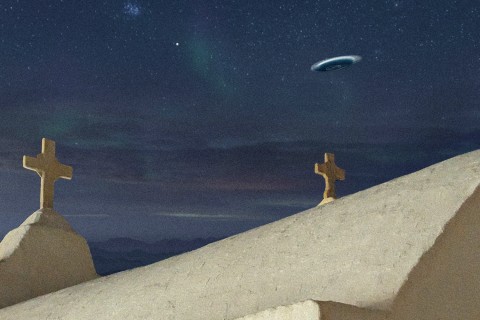Dual citizens
In Search of an American Catholicism: A History of Religion and Culture in Tension. By Jay P. Dolan. Oxford University Press, 336 pp., $28.00.
Has America been good for Catholicism? The recent clerical sexual-abuse scandals have given this question a new urgency. In response to episcopal arrogance and dereliction, many American Catholics—inspired by the best of both Catholic theology and American democracy—have called for greater lay participation and hierarchical accountability. On the other hand, the Colombian cardinal who heads the Vatican’s office for clergy has blamed American “pansexuality and sexual licentiousness” for fueling the crisis. Some Catholics contend that American journalism and law, through their aggressiveness, have contributed to a frenzy of anti-Catholicism, while still others thank—however qualifiedly—these institutions for exposing the scandals.
The tension, even conflict, between “American” and “Catholic” is nothing new, but stretches back to the founding of the Republic. Jay Dolan, emeritus professor at Notre Dame and a pioneer in the field of American Catholic history, has devoted his scholarly life to the study of that tension. Clearly written and accessible to the general reader, In Search of an American Catholicism is the capstone to his celebrated career. Put simply, he argues that America has been quite good for Catholicism and that Catholicism must continue to adapt to American culture if it is to endure, let alone flourish.
Dolan begins his narrative with the emergence of “republican Catholicism,” marked by an enlightened, tolerant piety and by American individualism and democracy; John Carroll, the first American bishop, was elected in 1789 by his fellow clergy rather than appointed by Rome. By 1840, growing Roman control combined with European immigration to form a Catholicism characterized by increasing ritualism and papal devotion; it also gave birth to the anti-Catholic Nativism of the Know-Nothings and the Ku Klux Klan.
As immigrant—especially Irish—Catholics became more established by the end of the 19th century, the “Americanist” controversy arose through the efforts of leading intellectuals and clergy like Archbishop John Ireland of St. Paul to harmonize American and Catholic ideals. The subsequent papal condemnation of “Americanism,” however, did not stunt the growth of the Catholic Church. By mid-century, Catholicism was increasingly comfortable in, and yet still marginal to, American society. The Christian Century, for example, in the mid-1940s ran a series of articles, “Can Catholicism Win America?,” that warned against an alleged Catholic plot to take over the country and subvert democracy.
The 1960s witnessed the vindication of Catholicism in the U.S. and of American Catholicism. The election of John F. Kennedy signaled Catholic acceptance into the cultural mainstream, while the Second Vatican Council—largely through the work of the formerly silenced American Jesuit John Courtney Murray—supported the right to religious freedom and discounted church-state alliances. Soon enough, though, the American church found itself increasingly torn between being a democratic “people’s church” and the restorationist “bureaucratic church” exemplified by Pope John Paul II. The sexual-abuse crises, Dolan concludes in a postscript, reveal the failure of this monarchical church and the need for a more democratic American Catholicism.
The commendable breadth of Dolan’s narrative unfortunately saps it of depth, leading to occasional superficiality and even jejuneness, e.g.: “Although the abortion debate has divided Catholics, they still expect their religious leaders to speak out on public issues.” Later chapters often tediously repeat the arguments of preceding ones. Moreover, despite added emphasis on such themes as gender and ethnicity, the book itself largely condenses and recapitulates—sometimes verbatim—Dolan’s 1985 classic The American Catholic Experience.
More substantially, Dolan fails to address the question of whether America has been bad for Catholicism. He offers a one-sided, even simplistic narrative in which a European, Roman church seeks to rein in the democratic vision of American Catholicism. There is little sense that the drive to be more American has—along with affording benefits that are increasingly underappreciated by traditionalists and progressives alike—sometimes wounded Catholicism. Like many Catholics of a certain age, for instance, Dolan venerates President Kennedy as the one who indissolubly married America and Catholicism. But he fails to mention that Kennedy’s landmark 1960 speech in Houston to Protestant ministers—which allayed concerns that a Catholic president would be beholden to the pope—eviscerated the public character of his Catholicism by denying that his belief would have any effect upon his governance.
What does it say that, 40 years after Kennedy, when Catholics as a whole enjoy unprecedented assimilation into American society, a Catholic politician who adheres to his or her church’s consistent ethic of life (opposition to the death penalty and euthanasia; defense of the right-to-life of the unborn and of governmental support for the poor) stands virtually no chance of winning the presidential nomination of either major party? American Catholics, as Commonweal editor Margaret O’Brien Steinfels has noted, find themselves politically homeless. (Contrary to Dolan, that homelessness—political or otherwise—may not be such a bad thing for the vitality of either Catholicism or America.)
Ultimately, while Dolan correctly identifies the clash between hierarchical and democratic tendencies as the fundamental tension in American Catholicism, he errs in holding that it is only the hierarchical that must adapt. When he comments that John Paul II’s supposed revival of the “authoritarian tradition of Catholicism” must be resisted so that, as he writes elsewhere, “the romance with modernity may begin again,” cliché segues into blithe disregard of the damage inflicted by the “acids of modernity.” Nor does he evince much concern that full assimilation into American society might lead to Catholic impotence and dissolution, as it has done for much of mainline Protestantism. Charles Morris’s 1997 American Catholic, for one, provides a more nuanced and insightful exploration of the potential and the peril of that encounter.
Dolan is surely right that America has been a blessing for Catholicism; recent scandals notwithstanding, the American church remains the most vigorous in Western Catholicism. But the encounter between Catholicism and the U.S. is more complicated—and interesting—than Dolan allows. That richer story awaits new historians and writers freed from the polarizations that define the Vatican II generation.





